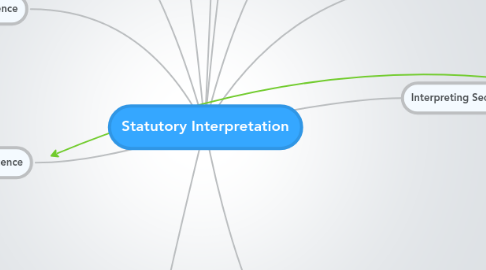
1. History
1.1. Traditionally, unwritten law was given sovereignty and written law was just a support system then in the tudor period when separation of powers happened this was reversed.
2. Background
2.1. Legislation cannot be overruled for being unconstitutional, note occasional attempts e.g. British Railway Board v Pickin 1974
3. Rules or Primary Aid to Interpretation
3.1. Literal Rule
3.1.1. Plain or literal meaning of words as they have been carefully selected by draftsman.
3.1.1.1. Not a true reflection of reality coz words are not clear
3.1.1.1.1. R V Harris 1836, the statute made it an offence to 'stab, cut or wound' but Harris bit her friends nose in a fight and policeman's finger, she was not charged guilty under this act as the whole act made reference to injury via weapon and teeth are not weapons.
3.1.2. Petere fontes - looking at words of statutes
3.2. Golden or Purposive Rule
3.2.1. What is intended by draftsman in this act by looking at general purposes section and the context
3.2.1.1. Growing trend for judges to follow this method
3.2.1.1.1. Re Sigsworth 1935 - son killed mother even though he was in line for inheritance but he wasn't in this cause it was deemed the purpose of act wasn't to reward murderers
3.2.2. Imaginative reconstruction adding/removing words
3.2.2.1. Adler v George 1964
3.2.2.1.1. The court added ‘on’ to avoid the absurd result of G. On or of the vicinity. not being prosecuted because he was caught inside and not in the vicinity of the base
3.3. Mischief Rule
3.3.1. History of the act to see what was the act trying to remedy
3.3.1.1. Started with Heydon's case 1584 - At that time the reason for Act's existence was always stated in preamble
3.3.1.1.1. Smith v Hughes 1960 , Street Offences Act 1959 stated that prostitutes were not allowed to loiter or solicit in the streets, however 6 prostitutes started signalling on windows and balconies by using finger gestures for prices etc so judges saw the point of act was to remedy having such behaviour on the street so by making this an offence we can make sure the mischief is remedied.
3.4. Rules are techniques for reading documents and may be followed singularly or in combination
4. Styles
4.1. Llewelyn's grand and formal styles grand is flexible and formal is tight
4.2. Judges personality affects what style or rule they use.
5. HR Influence
5.1. THe HRA 1998 SELECTIVELY INCORPORATES ELEMENTS of echr by giving them special legal statute as 'convention rights' and judges are required to interpret legislation so far as possible to achieve consistency with these convention rights. thus sometimes judges have to rethink legislation completely
6. EU Influence
6.1. EC legislation is founded on the assumption that a purposive approach will be used when dealing with S.I
6.2. Lister v Forth Dry Dock 1990, ditched literal approach and went for very wide purposive approach as a Directive of EC was in concern
6.3. 10 EC imposes an obligation on the national court to interpret national law in the light of the wording and the purpose of Community law... in so far as it is given discretion to do so under national law.
7. Ann v London Merton Council
8. Consumer Protection Act
9. Secondary aids to construction
9.1. Internal
9.1.1. The title of the act
9.1.2. Inclusory words and lists
9.1.2.1. Rules of Grammar
9.1.2.1.1. Expressio Unius est exclusio alterius
9.1.2.1.2. Eiusdem Generis rule
9.1.2.1.3. Noscitur a Sociis
9.1.2.1.4. Ignorantia leges non excusat
9.1.3. Other statutes of the same matter "in pari materia"
9.1.4. Punction
9.2. External
9.2.1. The Interpretation Act 1978
9.2.1.1. clarifies stuff like he is seen to include she
9.2.2. Dictionaries
9.2.3. Travaux Preparatoires
9.2.3.1. Preparatory works such as reports of working papers
9.2.4. Hansard
9.2.4.1. Parliamentary Debates
9.2.4.2. De Bene Esse Approach 'for what its worth' look at the evidence but not make a ruling on ir
9.2.4.3. Pepper v Hart 1992 - 6 to 1 majority to use Hansard
9.2.4.3.1. following pepper v hart use of hansard was limited
9.2.4.4. The Practice Direction
10. Interpreting Secondary legislation
10.1. There are additional aids as they have a parent Act
10.1.1. Context
10.1.2. parent act
10.1.3. looking at similar regulations
10.1.4. Common law - must be in line with common law
10.1.5. Principle of validity - where excess of power than that which was granted by parliament is used
